

European
Nuclear Society
e-news
issue 39: February 2013
It is probably fair to say that many European citizens are not fully aware of the multiple applications of nuclear technology. Most of them will be aware of how nuclear power plants generate electricity, but perhaps many are less aware of the fact that nuclear technology contributes greatly to our quality of life by providing tailor-made solutions to problems affecting agriculture and other industrial sectors, as well as by identifying methods of early diagnosis and treatment that help save thousands of lives every day. Of course, there is a vast range of basic and applied research being carried out by research teams across the length and breadth of Europe – and beyond. Research projects range from the large-scale to medium and small-scale ones. This statement might seem like a platitude to many readers, but does the average casual internet surfer that reads ENS NEWS realise it? Unfortunately, without the oxygen of publicity the fruits of applied nuclear research are less likely to get the recognition that they deserve and life-enhancing applications may never be properly exploited.
One area of research that is being spoken about more and more, both within the nuclear community and with decision-makers and other stakeholders, is that of small modular reactors (SMRs). Two events (one that took place recently and another that is soon to take place) provide evidence of this fact. On 30 January 2013, the Nuclear Industry Association (NIA) in the UK organised a conference in London dedicated to SMRs. On 28 February 2013, FORATOM is organising in Brussels, in cooperation with the Belgian Nuclear Society (BNS), an ENS member, a workshop dedicated to this topic. Experts from the world of research, academia, industry and the media, as well as senior politicians, were present in London, and will be in Brussels, to debate the future prospects for this exciting application of nuclear technology. Many advocates of SMRs are confident that SMRs will create and sustain a lucrative new market niche for the global nuclear industry. At the same time, they will help provide a vital source of energy in locations where it is currently difficult to obtain.
The concept of small modular reactors, which are sometimes referred to as “mini or “medium-size” reactors, is not a new one for the research community. Indeed, SMRs already power nuclear submarines and have helped propel space craft into orbit around the earth. But it is the more pragmatic question of how SMRs, generating anything from 100 - 600 MWe, could deliver electricity where no electricity grid is currently available, or where the construction of large-scale nuclear power plants is simply not an option. A series of SMRs working in tandem could be manufactured and assembled in a central factory and then brought to a site and installed. This is the essence of the modular approach. Because SMRs don’t need to be hooked up to existing large power grids, remote or isolated communities without access to base-load power could thus benefit from access to a flexible and alternative source of energy and thereby enable them to escape the energy poverty trap. It’s all about developing reactors that are adapted to suit the scale and requirements of different kinds of electricity production. Necessity is the mother of invention.
SMRs are also designed to use new fuels that allow higher burn-up rates and longer life-cycles, which will result in the production of smaller amounts of radioactive waste. What’s more, a modular approach also offers greater containment efficiency and materials security, which results in a very high level of safety and low level of risk of proliferation. With citizens so preoccupied by nuclear safety the question of radioactive waste management and proliferation, SMRs could go a long way to reassuring them that nuclear technology provides solutions to these crucial challenges. SMRs also testify eloquently to the fact that small can be beautiful too.
If you are working in the frontline of research into SMRs I would like to invite you to share with ENS NEWS readers the current status of your work and outline your hopes and aspirations for this potentially exciting new application of nuclear technology.
|
http://www.euronuclear.org/e-news/e-news-39/presidents-contribution.htm


We finished off last year with the successful ENC2012 conference, in Manchester, UK. In parallel with ENC 2012, which is the biggest conference on the ENS events calendar, we launched an initiative called ENC Careers, an event similar to a job fair. It enabled our corporate members to make contact with potential employees that might subsequently fill job vacancies within their organisations. The feedback on the event that was obtained from both companies and job candidates was so positive that the Board of ENS decided after ENC2012 that the ENC Careers initiative will be repeated in 2013. At this point I would like to urge our corporate members to make the most of the opportunity that ENC Careers offers them and to take part actively in the 2013 edition.
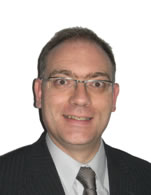 |
During ENC2012 ENS encountered a new challenge: How can we make the conference more attractive for nuclear power plant operators, who are our biggest customers? Unfortunately, the profile of nuclear power plants is sometimes very poor. So, the ENS Board decided to establish a task force to increase accordingly the attractiveness of the conference next time. At the end of last year, ENS initiated a new cooperative venture, with the European Research Materials Society (E-MRS), for the joint organisation of an event devoted |
|---|
to nuclear materials. The E-MRS is once again organising its own well-known symposium dedicated to this topic, during its Spring Meeting, in Strasbourg (from 27-31 May).
ENS for its part is looking forward to the series of conferences that it is organising in 2013, which include PIME, in Zurich (17-20 February); ETRAP, in Vienna (13-15 March) and RRFM in St. Petersburg (21-25 April). In fact, by the time you read this Word from the President, PIME 2013, which is an ENS conference exclusively for nuclear communications professionals, will already have taken place! This year PIME celebrated its twenty-fifth anniversary. For any conference to achieve a silver jubilee is a remarkable thing in itself. But this impressive anniversary also eloquently expresses the enduring commitment of the European nuclear industry and research community to articulating - to as wide an audience as possible - the core messages about the benefits of nuclear energy. Twenty-five years and still going….PIME shows that nuclear communications remain as relevant as ever.
The ENS Young Generation Network is planning its biannual conference, the European Nuclear Young Generation Forum, which will take place this year in June, in Stockholm. Please support your young employees by inviting them to attend this outstanding conference. Registration is available at: www.ENYGF2013.com
The first great challenge of the year for ENS staff will be the move to the Society’s new offices in Brussels. As of the beginning of April 2013 our new address will be: 56 Avenue des Arts, 1000 Brussels.
Finally, as ENS president I was offered at the end of last year a seat on the Governing Board of the the Sustainable Nuclear Energy Technology Platform (SNETP) for a period of two years. This gives me an opportunity to further represent the interests of the Society via the medium of this important scientific stakeholder Platform; one additional way of promoting the work of our Society on a European level.
I would like to wish all of you a successful, enjoyable and fulfilling 2013!
Marco Streit
President of ENS
http://www.euronuclear.org/e-news/e-news-39/HSC.htm


The ENS Higher Scientific Council (HSC) is concerned about the current negative developments within some Member States of the EU and the consequential reduced perspectives in the field of nuclear energy technology, education, research and development. The HSC believes that the use of nuclear energy provides an essential contribution to the secure, clean and affordable energy supply for electricity generation, and that this will remain for at least the rest of this century.
The HSC, therefore, strongly recommends that within the EU the resources that are allocated to nuclear education and training and to nuclear R&D reflect the increasing globalization of nuclear power and the needs of Member States that will have nuclear power or decommissioning programmes for decades to come.
In addition, the HSC recommends that the nuclear industry should actively encourage the setting up of knowledge transfer mechanisms to ensure that the knowledge, know-how and experiences of the current generation of professionals within the industry is not lost to the young people starting a career in nuclear. Mobility programmes to support and encourage young professionals to work across the EU to gain wider experience of nuclear power operations should be set up. These activities should help young professionals working in the nuclear technology field to expand long-life networks and business connections and thereby be better prepared for the challenges of the 21st century.
The use of nuclear energy for electricity production within the European Union is mixed, with some countries planning to enhance the use of nuclear energy, some aiming to maintain their current programmes and others intending to withdraw from the use of nuclear energy and decommission their nuclear facilities. Irrespective of whichever path is being taken the provision of suitable qualified and experienced people to undertake the necessary tasks associated with the design, construction, commissioning, operation and decommissioning, is of vital importance not only to the safety and security of the nuclear industry, but also to its sustainability.
The uncertainty within the European Union over the use of nuclear energy over the past thirty years as a result of a combination of worries caused by nuclear accidents and the abundance of cheap gas has resulted in the stagnation of the nuclear industry in many countries. This stagnation and the perceived lack of a long-term future has had an adverse impact on the attractiveness of the nuclear industry to young engineers and scientists. The lack of interest from young people in the industry and the lack of support from some Member States and from the EU as a whole has had a consequential knock-on effect in the universities, higher education colleges and technical training schools. The number of universities and colleges delivering nuclear education programmes has declined.
A consequence of all this is that the age distribution of workers in the nuclear industry is now biased toward the upper end, with many likely to retire in the next 10 years. This presents all Member States with nuclear power programmes with a problem irrespective of which trajectory they are on. Even countries planning to withdraw from nuclear power and decommission their plants will need nuclear engineers and scientists for many decades to come to safely decommission the nuclear power plants, manage the spent fuel and radioactive waste.
The current state of affairs presents the EU with a number of challenges:
How to capture the knowledge of those in the nuclear industry who will retire in the next decade, so that all their experience and the lessons learned by the nuclear industry will not be lost.
How to make the nuclear industry attractive to young engineers and scientists, so that the aspirations of Member States; whether to expand their use of nuclear power, maintain their current programmes or withdraw from nuclear power and decommission their nuclear power stations and other nuclear facilities; can be met for decades to come.
How can the decline in the nuclear education and training programmes be reversed and universities and colleges be persuaded to develop and deliver the necessary nuclear engineering and science programmes to provide the nuclear workforce of the future.
Meeting these challenges will not be easy, it will take commitment and resources.
At the beginning of this century the growing recognition of climate change and the need to decarbonize the generation of electricity was becoming obvious. The perception of nuclear power changed and it became seen as a major source of “CO2 free” electricity production. Many countries initiated new nuclear programmes to cope with future electricity needs. However, the short timescales needed to deliver the new power station programmes highlighted a number of challenges. It was immediately obvious that there were insufficient manufacturing facilities to meet the potential demand and it was also obvious there would be skill shortage not only in the supply chain but also to design, construct, commission, operate the new facilities, and to decommission the old plants.
Organizations such as NEA, IAEA, and the JRC, published a number of reports [1-8] indicating the loss of knowledge and experience due to ageing and retirement of staff. In the UK, because of its extensive nuclear programme lasting over 6 decades the challenge was not only to decommission its old nuclear power stations and other fuel cycle related sites, but also to maintain its existing programme and deliver a new nuclear power programme. The COGENT sector skills council, in conjunction with the National Skills Academy for Nuclear, produced three excellent reports on the skills needed to deliver the UK’s nuclear programme up to 2025. [9,10 and 11]
The accident at Fukushima had mixed implications for the EU. Some accepted, without being complacent, that the accident could have been avoided and that their nuclear power plants and the nuclear safety regulatory frameworks were sufficiently robust. Others, such as Germany, Switzerland and Belgium, in spite of successfully using nuclear power for some 50 years, decided to shut-down earlier or not extend their nuclear power plants lifetime. These decisions have caused young engineers and scientists in the affected countries to again question the attractions of a future in nuclear power. Young, talented people are, not surprisingly, leaving for other sectors.
The EU Member States that have turned their backs on nuclear power are contributing to the demise of nuclear R&D and education within Europe. However, the situation is not uniform across the EU and some Member States have recognized the dangers, such as the report from the Science and Technology Committee of the House of Lords [12] in the United Kingdom. The UK has also recognized the need to rebuild its specialist nuclear related education and training [13] to meet the projected skills shortfall.
Europe depends on nuclear energy for 27% of its electricity generation [14]. If Europe is to maintain its standard of living, meet the challenges from climate change and the need to reduce greenhouse gas emissions, together with the increasing global demand for fossil fuel, the contribution from nuclear power will have to increase throughout the rest of this century. The challenge to maintain European prosperity and at the same time reduce dependency on fossil fuels will only be met by an appropriate mix of affordable energy sources. Nuclear energy is a proven, reliable and affordable means of generating electricity without having an adverse impact on climate change. On a global scale the use of nuclear energy is increasing. The projected growth in the use of nuclear energy in the developing world will make the large-scale use of nuclear power a reality as developing countries increase their prosperity. Europe should welcome this as a positive contribution to the protection of our planet and be prepared to contribute to this growing market opportunity.
The continued, safe and secure, use of nuclear energy to support both European and global electricity supply will require well-educated and trained people with a deep knowledge of nuclear related technologies for decades to come. The continued supply of such people will require Europe to have comprehensive science and engineering education capability and robust nuclear R&D programmes at national and EU levels.
The lack of enthusiasm for the use of nuclear energy for electricity production in some parts of the EU has meant that nuclear fission energy related budgets are being cut. Nuclear fission R&D budgets within Europe which have effectively been reduced in the past decade are now under more pressure because of the lack of political commitment and realism regarding the need for the use of nuclear power to ensure that Europe has an adequate energy infrastructure in the coming decades.
[1] EHRO-N report: Putting into perspective the supply of and demand for nuclear experts by 2020 within the EU-27 nuclear Energy sector : JRC Scientific & policy Report, EUR 25291 EN, ISBN 978-92-79-21276-5, ISSN 1831-9424, doi:10.2790/47738
[2] OECD2012/NEA report : Nuclear Education and Training from Concern to Capability. 24 Apr 2012 ISBN: 9789264176379 OECD Code: 662012011P1
[3] Status and Trends in Nuclear Education : IAEA Report : ISBN 978-92-0-109010-2, www-pub.iaea.org/MTCD/publications/PDF/P1475_web.pdf
[4] Human Resources for Nuclear Power Expansion
www.iaea.org/About/Policy/GC/GC54/GC54InfDocuments/English/gc54inf-3-att5_en.pdf
[5] "Energy Roadmap 2050" (COM(2011) 885 (Brussels, 15.12.2011))
eur-ex.europa.eu/LexUriServ/LexUriServ.do?uri=COM:2011:0885:FIN:EN:PDF
[6] www.enen-assoc.org/en/training/for-nuclear-community/efts-fp7.html
[8] www.enen-assoc.org/
[9] COGENT, Power People, The Civil Nuclear Workforce 2009 – 2025, Renaissance Nuclear Skills Series 1, www.cogent-ssc.com
[10] COGENT, Next Generation, Skill for New Build, Renaissance Nuclear Skills Series 2, www.cogent-ssc.com
[11] COGENT, Assurance, Skills for Nuclear Defence, Renaissance Nuclear Skills Series 3, www.cogent-ssc.com
[12] House of Lords, Nuclear research and Development Capabilities; Science and Technology Committee, 3rd Report of Session 2010-2012, November 2011
[13] National Skills Academy for Nuclear, UK Nuclear Education, skills & Training Directory, NSAN 2013, enquiries@nuclear.nsacademy.co.uk
[14] www.eurelectric.org/powerstats2012/
http://www.euronuclear.org/e-news/e-news-39/enc2012-career-event.htm

The ENC 2012 Careers Event took place in Manchester, on 9 December, at a beautiful venue - the famous Manchester Town Hall. It was organised in collaboration with the ENS - Young Generation Network (ENS-YGN), Women in Nuclear (WiN) Europe and the Nuclear Institute (UK). During the early stages of preparation for this event ENS faced a lot of challenges: How to attract the candidates? How could it attract the recruiters? The first interviews with potential partners helped us to prepare a clear planning schedule for the event and to develop the strategy to promote it.
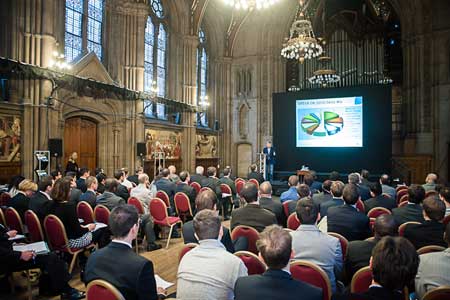
Thanks to the active promotional campaign carried out via the ENS website, in newsletters, by the ENS-YGN and via LinkedIn Groups and Twitter, the ENC 2012 Careers Event turned out to be a great success. Candidates from over 30 countries responded to the job offers. They included highly-skilled people (nearly two thirds - 59% - having completed an MSc, 21% a BSc and 20% a PhD) at various stages of their careers – from those who had just embarked on their chosen career to others with more than 10 years’ experience. So, not surprisingly, most of them were offered a face-to-face interview with a prospective employer.
Nine leading energy companies decided to become our “Careers Event Partners”: AREVA, ATKINS, EDF, EDF Energy, ONET Technologies, Rolls Royce, ROSATOM, Slovenske Elektrarne and Westinghouse. We divided the partner companies in 2 groups: one that informed people about the available job opportunities and the other that came to Manchester to interview the candidates. The “Interviewing Partners” were looking for experts with between 0 and 10 years’ of experience in different nuclear-related disciplines, such as maintenance, waste management or welding. The “Informing Partners” presented to visitors to their stands the profile of their company and the job opportunities on offer.
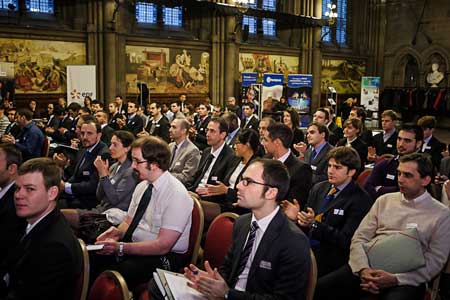
On the first day of the event, during the morning session, the 9 participating companies presented themselves, explaining the wide range of nuclear career paths available and underlining the attractiveness of working in the nuclear sector. The afternoon session was set aside for the pre-scheduled interviews, for intensive networking between the candidates and for discussions with potential employees at the partners’ information stands. In addition, WiN Europe organised a “CV Checker” stand, where two WiN members advised candidates on how to edit a perfect CV. The stand was very popular and the candidates very much appreciated the valuable comments that they received about their CVs.
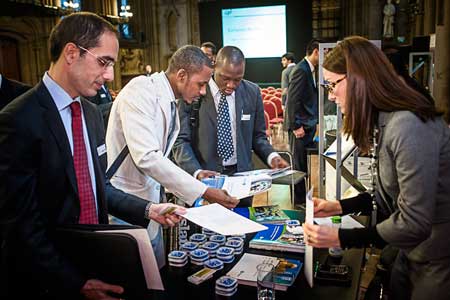
During ENC 2012 Careers Event the ENS–YGN network also organised its own side event. In addition to manning its own stand, ENS-YGN also gave information about their activities and encouraged young people interested in working in the nuclear sector to join the network, and organised a communications workshop entitled: How to deliver your idea. During the first part of the workshop a professional communicator explained how to present a technical subject in a way that makes it understandable by a non-technical public. Afterwards, the workshop participants were asked to get together in working groups, focus on one specific technical issue, and then present it to participants in an interesting and comprehensible way. Participants then voted for the best presentations and the winners received coffee cups - to enable them to stay awake whenever listening to boring presentations!
On the second day of the ENS 2012 Careers Event, the interviews with candidates continued. Candidates were given a great opportunity to visit the technical stands of the 78 exhibitors that presented their products during ENC 2012. This helped ENC 2012 Careers Event participants to receive additional technical information and to ask more questions about the job profiles. Another added value provided for the young professionals was the possibility of active networking with the ENC 2012 delegates.
The ENC 2013 Careers Event was a great success. Its objective was to establish a common platform for the coming together of young people and nuclear companies looking for employees.
Following the positive feedback received by participating candidates and companies, ENS has decided to continue organising the ENC Careers Event in the future, as it will play an important role in securing the nuclear competences that our industry needs to sustain it in the years ahead.
Emilia Janisz, External Relations Officer, ENS
http://www.euronuclear.org/e-news/e-news-39/ETRAP2013.htm


12 - 15 March ,Vienna, Austria
To fully benefit from the peaceful uses of ionising radiation that are found in industry, medicine, agriculture and research, and nuclear power generation, both people and the environment need to be protected. Education and training in radiation protection is therefore essential to building and maintaining the competent workforce that is necessary for establishing and maintaining the safe and well-regulated working environment that is demanded by modern society. The importance of such education and training has been acknowledged for many years, and a wide range of programmes and initiatives have been established at the national, regional and international level.
ETRAP 2013 provides a forum for decision-makers, regulators, educational and training providers and practitioners, researchers, radiation protection experts and persons from international organizations to discuss the current state of the art in education and training in radiation protection. The conference aims to identify current trends and good practices in the area while looking to the future so that society can continue to benefit from the many uses of ionizing radiation.
More information on ETRAP 2013 is available at www.etrap2013.org
ETRAP 2013 Conference Secretariat
and:
supported by:
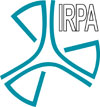 |
|---|
http://www.euronuclear.org/e-news/e-news-39/rrfm2013.htm


This year the European Research Reactor Conference (RRFM) will be organised from 21 - 25 April 2013 in Saint Petersburg, The Russian Federation.
All Areas of the Nuclear Fuel Cycle of Research Reactors will remain a key focus of this years’ programme.
Furthermore delegates at RRFM 2012 will discuss:
Innovative methods in research reactor analysis and design
Utilization of Research Reactors
New Research Reactor Projects
Research Reactor Operation, Maintenance and Safety Reassessment
Following last years’ success and highlighting the important work done in the area, this year’s programme will again feature a session on ‘Complementary Safety Assessment of Research Reactors following the Fukushima-Dai-Ichi NPP’s Accident’. And last but not least our Russian partners will present their ‘PIK’ reactor.
Further information on RRFM 2013 and the preliminary programme is available at www.rrfm2013.org
It is now possible to register for RRFM 2013. We strongly recommend doing so as soon as possible in particular if you intend to participate in one of the technical tours. Please note that the local organizer, ATOMEXPO LLC, will have to transfer the final list of participants of all technical tours, including their IDs/passport numbers no later the 25th of February to the relevant authorities.
Support for VISA application:
ATOMEXPO LLC, the local organiser of RRFM 2013 will support the VISA application process: upon reception of the registration form and a scan of the ID-document/passport, ATOMEXPO LLC will forward this information to the VISA department of ROSATOM. ROSATOM will process the information and each participant will receive a VISA-number from the Ministry of Foreign Affairs of Russia. Delegates should then present themselves with this number at the Embassy of Russia in their respective country. Please note that this process will take about 10 working days and that the Russian Embassy will also need some time to issue a VISA. We therefore recommend registering early for RRFM 2013!
organised in cooperation with:
http://www.euronuclear.org/e-news/e-news-39/NESTet2013.htm


NESTet is designed to facilitate an exchange of information and the sharing of best practice. It is an important networking opportunity for better co-ordination and collaboration between different stakeholders in nuclear education.
The NESTet Programme Committee is calling for papers regarding the following topics:
What are the needs with regard to nuclear education and training? How can we train for an effective safety culture? Feed-back is thought from industry (operators, providers, suppliers, ..), regulators, safety authorities and research institutions on skills and profiles required to ensure an efficiently and safely performing nuclear sector.
While all levels are of interest, NESTet 2013 would particularly like to look at entry level skills needed across the nuclear sector. Another area of special interest is the need for ‘nuclearisation’ professions in construction and component manufacturing.
What are the answers that help to close the gap? This is all about sharing best practice and examples of co-operation between different stakeholders and about training and education programmes that are able to cover needs.
The NESTet 2013 Programme Committee encourages joint presentations of academia and industry on successful partnerships that help bridging the gap between the learning and the training world.
How do organisations build the leadership team´s capacity to successfully lead your organization and to improve performance? How do they organise transformational change and culture change? How do they create an environment that is safe and supportive to explore and develop new ways of being and doing? How to they organise leadership training? How do they enable leaders to take the right decisions?
Where are efforts on harmonisation needed? Harmonisation is part of effective strategies for nuclear education and training; it is also a pre-requisite for workforce mobility. Given the increasing globalisation of the nuclear sector the NESTet 2013 Programme Committee is in particular calling for initiatives on a European level and best practice examples that can be extended to an international context.
How to ensure that enough motivated workforce is available for the nuclear sector? How to encourage skilled professionals with general engineering or project management competence to join the nuclear sector? How do you attract young professionals to the sector? How do you ensure skilled workforce in a context of a long-term-exit strategy? And last but not least: how did Fukushima influence the motivation to start a career in nuclear/enrol in nuclear related studies at Universities?
What are the experiences of countries with an emerging nuclear sector? How is training organised if a nuclear sector didn’t exist before and when new build might still be some years away? What kind of international support is required? What are best practice examples that other countries can learn from?
What are the interactions between nuclear education and civil society? What role should societal aspects of nuclear play in the education of nuclear professionals? How far can nuclear education extend to key stakeholders in society?
What is the situation with regard to infrastructure and tools for nuclear education and training? How can we overcome bottlenecks where the required infrastructure is not available in sufficient quantity and quality? How can collaboration, sharing of facilities and new emerging tools ensure the provision of the required infrastructure? What is the role and importance of experimental facilities? Has Fukushima forced to upgrade, change or improve nuclear training tools, training methods and training contents?
The NESTet 2013 Programme Committee is furthermore looking for input to a Young Generation Workshop on the use of new technologies for education and training. Young professionals and students should provide their view on how they see the future of learning and training. How should training methods and tools evolve in order to adapt to the change of habits in media use? What role can virtual knowledge capture, long distance training, e-learning, simulators, virtual engineering and other media play?
The NESTet Programme Committee welcomes both oral and poster submissions. If you wish to share knowledge and best practice in nuclear education and training in science, engineering and technology, please submit your abstract by 31 March 2013 through the NESTet Abstract Submission System.
More information on NESTet 2013 is available at www.nestet2013.org
NESTet 2013 Conference Secretariat
Fax: +32 2 502 3902
e-mail: nestet2013@euronuclear.org
http://www.euronuclear.org/e-news/e-news-39/nene2013.htm


In 2013, the Nuclear Society of Slovenia will organize the 22nd International Conference Nuclear Energy for New Europe. The conference will be held in the beautiful alpine resort of Bled, Slovenia, during September 9-12. The conference is a traditional annual meeting of professionals from nuclear research and educational institutions, nuclear vendors, utilities and regulatory bodies. It attracts around 200 participants from more than 20 countries. The topics discussed are general and include reactor physics, thermal hydraulics, probabilistic safety assessment, severe accidents, nuclear fusion, nuclear power plant operation, nuclear materials, waste management and new reactor designs. The leading theme of the conference will be New Generation(s) for Better Future. |
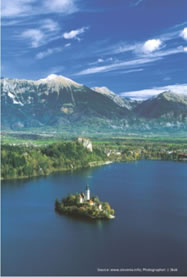 |
The conference website URL is www.nss.si/nene2013/.
For more information contact Dr. Mitja Uršič (mitja.ursic@ijs.si, tel: +386 1 5885 342).
http://www.euronuclear.org/e-news/e-news-39/hungary.htm

On 29 and 30 November 2012, the Annual Symposium on Nuclear Techniques took place at the Paks NPP, in Hungary. It was organized by the Hungarian Nuclear Society. The objective of the Annual Symposium is to promote information exchange among Hungarian nuclear experts working for various organizations, including utilities, the national regulatory body, universities, design and research institutes, etc. This year’s Annual Symposium was attended by more than 100 experts and about 35 presentations were made. The presentations covered a wide range of issues from the safety of operating units at Paks NPP to topics related to international fusion reactor research.
The organisation of the Annual Symposium was closely linked to major events taking place within the Hungarian Nuclear Society. These are:
The 30 years operational lifetime of Paks NPP Unit 1 was scheduled to end in December 2012. A roundtable discussion took place to discuss the preparatory activities of both the utility and the regulatory body with a view to extending the operation of the unit by 20 years (the permit to operate for a further 20 years was issued by the Hungarian Atomic Energy Authority on December 17, 2012).
The 30 years anniversary of the use of atomic energy for generating electricity was also celebrated in December 2012. Presentations made at the Annual Symposium also recalled the major milestones reached during the preparatory, commissioning and start-up phases of Paks NPP’s units. Some experts who participated in the original construction of the operating units are still working for the utility today or for various nuclear institutions. It was stressed that the transfer of their expert knowledge to subsequent generations is vital to the operation of the potential new units to be built at Paks NPP in the near future.
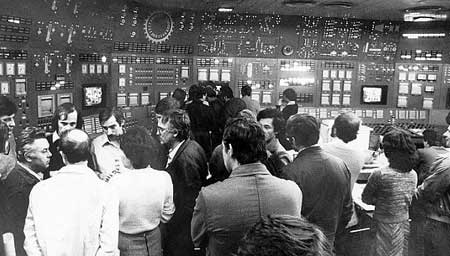
Detection of the first chain reaction at Paks NPP Unit14, at 21:45 on 14 December 1982.
http://www.euronuclear.org/e-news/e-news-39/sne-news.htm

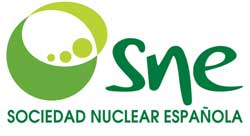
The Nuclear España Best Article Prize was awarded this year to Luis E. Herranz and Mónica García from CIEMAT for their article entitled Fukushima. El accidente severo (Fukushima. The severe accident).
The Committee also awarded, as was the case in previous years, an “Honorific Mention” to an article entitled 30 años de información nuclear (30 years of nuclear information), which was devoted to the 30th anniversary of the magazine of Spanish Nuclear Society (SNE), in recognition of its “distinguished technical quality and presentation.”
A runner-up award was presented to the article entitled: Fukushima. Un año después (Fukushima. One year later).
From 25 – 27 September 2013, the SNE’s 39th Annual Meeting will take place in Reus (Tarragona).
This annual meeting, which brings together industry leaders and senior representatives of the national and international nuclear generated electricity sector, also provides an interesting excuse for participants to get to know and enjoy the culture, landscape and gastronomy of Spain’s different regions.
On 19 February 2013, representatives of Spanish nuclear power plants will take part in the “Winter Annual Lecture” organised by the Escuela Técnica Superior de Ingenieros Industriales (Industrial Engineering School) of the Universidad Politécnica de Madrid. The lecture this year is entitled: "Experiences and Perspectives: Nuclear power plants in 2012" and will analyse the evolving situation at Garoña NPP over the past twelve months.
Nuclenor shut down Spain’s oldest nuclear power plant, the 466 MWe Santa Maria de Garoña NPP, in order to avoid paying new taxes as of 1 January 2013. The reactor was defueled by the end of December and will be dismantled.
http://www.euronuclear.org/e-news/e-news-39/snus.htm

All of us “eternal” students experience very similar feelings at the end of the summer - a kind of urge to buy at least one new exercise-book and pencil and, for the most eager among us, the need to enrol in a new course. I am one of those eternal students. I have fond memories of my school years. “Learning is joy”, I used to tell to my fellow university student when she was sitting over textbooks with a deep frown of suffering on her forehead. She always looked at me with disbelief when I said this.
Professor Jana Camara, from the Grammar School in Metodova Street in Bratislava, recognised this endlessly positive attitude that I had retained for my school days and came with her students to visit the Slovak Hydro-Meteorological Institute during an Open Door Day. She listened to me talk about radioactivity and radioactive matters for a while and then invited me to come and share this knowledge with her physics students.
When I arrived at school one Friday afternoon, there was a holiday mood in the air. The professor told me that she was utterly exhausted from the school year and when I learnt about all the activities that she had carried out with her students, I could quite understand why. Among other things, together with her teacher colleagues, she had organised the Fyzikfoto photography competition. The results of the competition were displayed in the school lobby and I was astonished to find out the various different ways in which physics is taught. I recollected the suffering of my own children, often frustrated after physics classes and especially with one textbook in particular that was written in such a way that I myself was tempted to throw it out of window.
Professor Camara and her colleagues looked at things in a different way. Declining numbers of physics classes required remedial new approaches. New motivational methods had to be employed to make students understand physical phenomena that occur around us throughout our whole lives. Fyzikfoto allows competitors to choose from the many phenomena around us, conduct an experiment using all the available photographic IT and graphical design technologies available to us today and to present the results. Every step offers the chance to learn something new, to watch physics in practice. Nobody can simply avoid how the results of physics affect our everyday life. Nor can the young guy who doubted that a car stops when we lift our foot off the accelerator. He helped me to understanding the driving style of many young men – the “break/accelerator” method. Physics was not their favourite subject.
Winners were selected from arrange of different categories. Diplomas, books and presents were distributed. Nice, I thought, they are potential new members of “Women in Nuclear”.
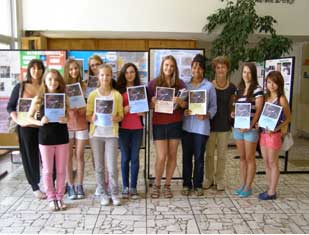
And then we all got together in the auditorium and I started to talk about the beginning of radiation monitoring at the Slovak Hydro-Meteorological Institute, back in 1962. Although the motivation behind for the radiation monitoring carried out by the Institute was the cold war nuclear tests that took place at that time (which I mentioned during the opening part of my presentation), I concentrated my talk instead on the history of the exploitation of nuclear energy for civilian purposes, mentioning those people whose insatiable curiosity led to the discoveries that eventually gave rise to today’s cutting edge technologies. In conclusion, I hoped that that curiosity that is so natural among students would accompany them throughout their whole lives and that they would manage to find the answers to their questions. Professor Camara expressed her astonishment that I was able to keep them captivated and quiet for an hour and a half. Personally, my view is that when we you really get to the heart of the matter it can’t be anything other than interesting.
In the end the winners of the competition were announced and I took my leave, deeply convinced that if one really puts one’s heart into something, success will follow. I doff my hat to all teachers that have not yet lost the belief in the common sense of this simple principle.
Tereza Melicherová,
SNUS, Women in Nuclear and
Radiation Protection Section
http://www.euronuclear.org/e-news/e-news-39/YG-Reporter.htm


The European Nuclear Conference (ENC) 2012 took place in Manchester, United Kingdom, from 9 – 12 December 2012. It was organised by the European Nuclear Society (ENS) in cooperation with a number of partners and attracted hundreds of professionals from about 40 countries to the Manchester Central Convention Complex, in the city’s historic Central Railway Station.
The topics that were covered included nuclear power and non-power applications and featured highly technical papers that addressed social and political questions within the post-Fukushima environment.
The social programme kicked off on Sunday, 9 December, with the Welcome Reception and conference pre-registration at Manchester Town Hall.

Experts from different fields, such as the research community, academia, governments, industry and other nuclear organisations, presented their views and discussed different topics related to the nuclear field. In addition to the registered participants, the high technical level of attendance at ENC 2012 was further supported by the participation of experts and senior managers from industrial companies such as General Electric, Westinghouse, Hitachi, AREVA, EDF, ROSATOM, Urenco, Iberdrola, Ansaldo Nucleare, Rolls Royce, etc.
The Opening Session of the conference on the morning of Monday 10 December was held in the Auditorium. It was chaired by Norman Harrison, President of the Nuclear Institute and co-chaired by Marco Streit, ENS President. It included the participation of several eminent people who delivered keynote speeches, including the Lord Mayor of Manchester.
During the Plenary Session entitled New Build a summary of the post-Fukushima European nuclear scenario was presented. The Plenary Session entitled Life Science and other Applications highlighted some of the varied applications of nuclear technology in the field of medicine (including diagnosis and epidemiology), space exploration, etc. The opening day concluded with a series of parallel sessions devoted to the following topics: New Build, Fuel Cycle, Plant Operations, Research Reactors and the Young Generation ENS-YG workshop entitled Building Bridges between Generations.
The social programme included the Conference Dinner, which was hosted in a unique location - one of Manchester’s most significant buildings, Manchester Cathedral. It was a great opportunity for participants to socialise and exchange thoughts and opinions about various nuclear and non-nuclear subjects.
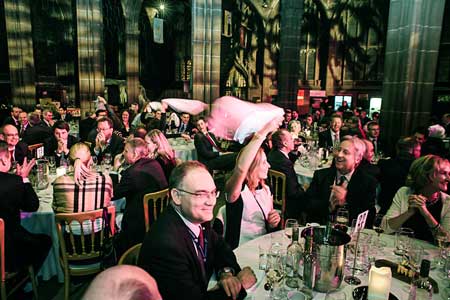
The second day of the event, Tuesday 12 December, started with a series of parallel sessions that introduced various interesting subjects, such as New Build, Plant Operations, End of use: Treatment/Remediation, Education and Training and Simulation & Generation III.
The Plenary Session entitled Fuel Cycle was chaired by Jean-Pol Poncelet, Director General of FORATOM, and co-chaired by Marco Streit, ENS President. It benefited from the contribution of top companies: Paul Harding, Urenco’s UK representative, presented a news update on the latest uranium enrichment technology and laid down a challenge to participants to consider and debate the possibility of replacing Uranium fuel with Thorium; Leo Shannen, from the Belgium Nuclear Materials Science Institute, summarised 50 years of Nuclear Fuel Qualification at SCK.CEN. In his presentation he also highlighted some concerns linked to proliferation; Marco Streit, from the Paul Sherrer Institute in Switzerland, presented developments in advanced fuel technologies and innovative small reactors research, as well as the innovative concept of fully closing the fuel cycle; Dominique Warin, of the CEA (France’s Atomic Energy and Alternative Energy Commission), shared with delegates the challenges posed by studies that the CEA is carrying out into minor-actinide bearing fuel options.
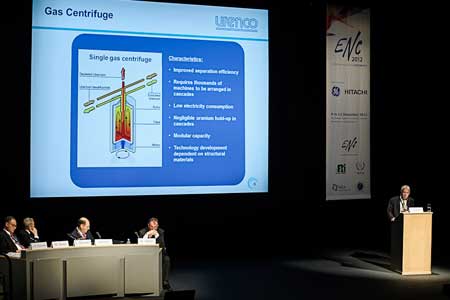
The day continued with a posters session, where specialists from different domains presented a summary of their work in a few slides and pictures. The titles of the poster sessions were: Education, Training and Knowledge Management, Plant Operations, New Build, Fuel Cycle, Life Science Application, Nuclear in the Civil Society, Non-power Industrial Applications, Reactor Technologies and End of Use.
Parallel sessions also took place on the second day of the conference. During the New Build session, A. Bugat from NucAdvisor, France, presented some ideas about how the IAEA’s Milestones Process can be reshaped taking into account the new post-Fukushima context and the fact that newcomers have arrived on the industrial scene. Also, he challenged the audience to think about what the real drivers of a nuclear project are today.
Olivier Rousselot, of EDF, the Manager of the EUR Revision D Project, summarised the goals and achievements of the licensing process for LWRs that have been licensed for 60 years. Even if the document he presented is not a regulatory document, it includes all safety principles, integrates all WENRA levels and fully considers both the lessons learned from Fukushima and the results of the stress tests. This will be of great help to newcomers in nuclear - and also to others who are less new.
The WNA’s Director of Licensing, Christian Raetzke, spoke about the licensing risks associated new nuclear build, as revealed by an industrial survey that focused on the interaction of the regulatory processes with the other processes involved (procurement, safety, etc.). There is no one-size-fits-all licensing model because of the very diverse regulatory frameworks and political and economic environments that exist in different countries. This is why the process varies not only from country to country, but also within the same country. When facing a FOAK (first-of-a kind) or a FIAC (first-in-a-country) scenario, where the licensing process can be approached differently, either in a one step or multi-step way, pre-licensing can be considered. When dealing with a NOAK (nth-of-a-kind), standardisation can facilitate the process.
Lydie Sartout, speaking on behalf of the french nuclear industry, presented the French approach to supporting a nuclear new build project abroad, stressing adaptability and flexibility and the life cycle of a nuclear project - whatever the individual country’s framework might be. She also noted some of the characteristics of the UK’s EPR Generic Design Assessment Project, which is an EDF and AREVA joint application project.
EDF’s Deputy Director of Planning and External Affairs, Stephen Walls, underlined some of the important milestones that have been reached with regards to future nuclear new build, as well as the key issues and the next steps facing it, including market structure, planning permits, licensing, waste disposals and investment decisions.
The final day of the conference began with parallel sessions and with a World Nuclear Transport Institute (WNTI) workshop entitled Transport of nuclear fuel cycle – Getting it where it is needed. This workshop featured representatives of International Nuclear Services, Westinghouse UAM and AREVA’s Business Logistics Unit. Other parallel sessions included the Women in Nuclear (WiN) Europe workshop entitled Nuclear Installation safety-research laboratories and raddioisotope production facilities: lessons learned from Fukushima, which was chaired by Anne-Marie Birac, of WiN Europe.
The Plenary Session Issues & Challenges for the Future of Nuclear took place in the Auditorium and featured the following presentations: The system cost of different power generation technologies: A New Look at the Competitiveness of Nuclear Power, The organisation of energy markets and nuclear opportunities, Nuclear Technologies for the future: Gen IV and Education, Training and Knowledge Management.
ENC 2012 was officially closed by the ENS President, Marco Streit, and the ENS Honorary President, Frank Deconinck. A concluding conference statement was made by Eileen Radde, of the Austrian Nuclear Society.
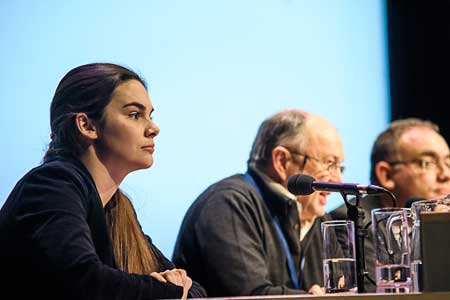
ENC2012 also hosted an exhibition, in which different companies presented their profiles and promoted their capabilities within the industry. This was another opportunity for participants to discuss, exchange views and share experiences.
The last event of the year, ENC2012 addressed and condensed a wide range of subjects. Participants looked back into history to identify the lessons that have been learned from various events and case studies. They also received an update on the current nuclear power and technology scenario. It was a step back that enabled them to look into the future. They were invited to imagine how visionary and challenging ideas today might one day be brought to life.
Elena Sima
Safety and Licensing Department
AMEC
Young Generation Romania
http://www.euronuclear.org/e-news/e-news-39/YG-Reporter-enc12.htm


The ENC 2012 conference kicked off on 10 December 2012, in Manchester (UK). The previous evening participants had attended the eve of conference Welcome Reception in Manchester Town Hall. At this impressive venue, Marco Streit, ENS President, and Norman Harrison, President of the Nuclear Institute and Chairman of ENC 2012, delivered an introductory speech. The Jan Runermark Award 2012 was then presented by the ENS Young Generation Network to Frank Carré, of the CEA (France). The ENC Career Event, which was organised by ENS and also took place on 9 December, was a great success.
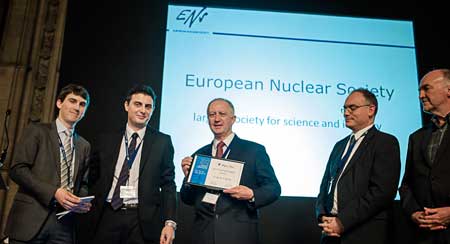
On 10, the Opening Session of ENC2012 featured addresses from senior experts and officials, who welcomed the participants, company representatives and policy-makers in attendance to what is the largest conference in Europe dedicated to nuclear energy.
Keynote speakers then delivered inspiring messages about the current state of nuclear energy and the challenges and opportunities that it faces. Mike Weightman, HM Chief Inspector of Nuclear Installations and Head of the Office for Nuclear Regulation in the UK, recalled the Fukushima Daiichi accident, the follow-up actions taken by the nuclear industry worldwide and some of lessons that have been learned. Mr. Weightman insisted on the specific values that the nuclear industry needs to express and represent, i.e. integrity, resilience, trust, adaptability and the importance of meeting challenges in order to ensure the highest level of safety.
This was followed by a presentation given by Alexander Bychkov, Deputy Director General at the IAEA. He explained that while the Agency’s annual growth forecasts for nuclear energy have been decreasing every year since 2010, they still foresee a rise of at least 25% by 2030 in the number of installed NPPs worldwide.
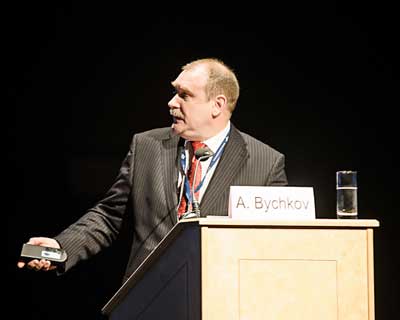
Dr. Tim Stone, Senior Chairman of the British government’s Office of Nuclear Development, which is part of the Department of Energy and Climate Change, reaffirmed how nuclear new build is not only important for his country’s energy mix, but also provides social and economic benefits for UK citizens. Nuclear energy projects could create thousands of new jobs. Dr. Stone hightlighted in a very interesting way the extreme changes that the nuclear energy business has undergone in recent years. He emphasised the need to rethink how to finance new nuclear projects. It seems clear that banking institutions are not prepared to finance the industry in the near future and that new mechanisms, such as institutional support/guaranties, are, therefore, going to be needed. The importance of “system cost” to the integration of grid development costs was also discussed. Last but not least, Dr. Stone reminded participants that TRUST is essential for developing the nuclear industry in the UK. Foreign investors need long-term commitments and guarantees on nuclear energy from government(s) to continue and or restart their investment programmes.
Jean-Pol Poncelet, FORATOM’s Director General, spoke then about public acceptance of nuclear in Europe and about the different reactions that occurred to the accident in Japan in March 2011. To conclude the Opening Session, Sir John Beddington, Chief Scientific Adviser to the UK Governement, stated that the drivers for nuclear energy development are still strong: climate change, population growth and increased urbanisation.
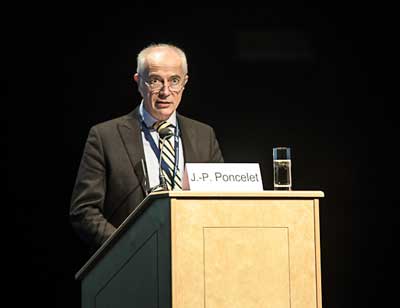
The next session was dedicated to nuclear new build. Vincent de Rivaz, CEO of EDF Energy, recalled the significant progress that has been accomplished by his company lately with regards to new nuclear development. He mentioned the recent site licence granted by ONR for EDF’s EPR project at Hinkley Point. Mr. de Rivaz also stressed the need for taking a prompt decision about going forward with new build projects. In addition, shale gas was also discussed and Mr. de Rivaz expressed the wish that exploration of this gas be accelerated. Last but not least, he urged ENC2012 participants to think “long-term” when making a decision on energy policy.
Eric P. Loewen, Immediate Past President of the American Nuclear Society (ANS), then presented ANS actions with regards to new build projects. Alexey Kalinin from Rosatom reviewed the different new build projects being undertaken by his company, as well as outlining its strategies and values.
The afternoon session was dedicated to Life Science and other applications of nuclear energy. Professor Stephane Lucas (Belgium) presented the challenges of hadrontherapy used in nuclear medicine applications. Cyclotron technology, which is used for 75% of patients worldwide, was also explained. The need to use carbon therapy instead of just protons was then discussed, as was the challenge of developing compact systems using this technology. Professor Lucas’s brilliant lecture helped participants to understand the need for using supraconductive magnets for hadrontherapy.
The next series of presentations were dedicated to the epidemiology of low-dose radiation, to an update on the ITER project - where more than 80% of contracts have been granted – and to the use of nuclear technology for space exploration.
The first day of ENC 2012 ended with a series of parallel sessions, where participants were able to interact with the panel of speakers on several topics, such as new build, the fuel cycle, plant operations or research reactors. A session was also organised by the ENS Young Generation Network on knowledge transfer. In the session on new build projects Dr. Fiona Rayment, from National Nuclear Laboratory (UK), presented the pros and cons of the nuclear fuel cycle in the UK, before discussing advantages of advanced nuclear systems, such as Generation IV projects. Uranium resources, Candu projects and reprocessing were also discussed by the panelists.
Denis Janin, Guillaume Chaud, SFEN – Young Generation Network
http://www.euronuclear.org/e-news/e-news-39/jan-runermark-award.htm

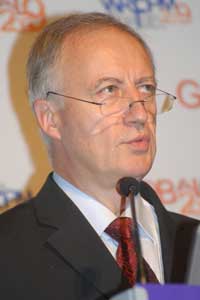 |
Frank Carré has a long and successful career in Nuclear Energy. He graduated from Ecole Centrale Paris in France and from MIT and Orsay University in Nuclear Engineering. Frank made his career at CEA, the French Atomic Energy Commission, where he held several managerial positions. He contributed to studies on advanced nuclear systems such as light water reactors, fusion reactor blankets and space power reactors. He is currently Scientific Director of the Nuclear Energy Division. Parallel to that, Frank Carré has always been very active in the education and promotion of youth peop le in the nuclear industry. Since 1985 he has been Professor at the INSTN in France. In addition, he holds since 2007 the chair “Sustainable Energy” at Ecole |
Polytechnique, where he is also in charge of nuclear engineering lectures. Frank is a member of the International Nuclear Energy Academy and gives regular lectures in international training programs, such as the World Nuclear University. Frank supervised several master thesis and PhD students and still encourages new students to discover the nuclear industry's challenges.
His activities among the French Nuclear Society (the SFEN) are highly appreciated. Among other, he developed the cooperation with the American Nuclear Society and its French chapter, particularly in enhancing cooperation in nuclear engineering education between those two countries. Frank has always been a strong supporter of SFEN-JG (French YGN) activities and we would like to thank him for that.
For his career path but also for his the dedication and support for youth in nuclear industry, the ENS YGN decided to award him the 2012 Jan Runermark Award.
Congratulations Frank!
http://www.euronuclear.org/e-news/e-news-39/SFEN-JG.htm

The 2012 edition of the annual Atoms for the Future conference took place in France from the 22 to 25 October. It focused on the “daily life" of nuclear power plants (NPP’s). The overarching topic of the conference sessions was NPP’s Operations & Maintenance.
Atoms for the Future 2012 consisted of two days of technical visits and two days of conference sessions. The event brought together 250 participants from 12 different countries, including Belgium, Japan, China, Austria, the United Kingdom, Germany, Switzerland, Italy, Poland, Slovakia, Spain and the USA.
Atoms for the Future 2012 kicked off with two days of technical visits for a total of 40 participants from different countries and backgrounds. Each visit began with a theoretical introduction to familiarise participants with the basic technical knowledge they needed to fully enjoy the visit. On the first day participants had an opportunity to visit AREVA facilities in the Chalon area: the Creusot factories and the Chalon/Saint-Marcel plant. The former is where some of the NPP’s large components, such as steam generators, pressurisers, etc. are forged. The latter is where steam generators, reactor vessels, pressurisers and other large components are produced and assembled.

On the second day, participants visited EDF’s Nogent NPP. The tour included a look round the maintenance training centre, the control room simulator, the turbine hall and the fuel storage building (controlled area). According to the participants, the tour was a unique chance to get a better understanding of the different tasks performed in an NPP. It also helped them to appreciate the challenges of working in an NPP and, therefore, the need for extensive training.
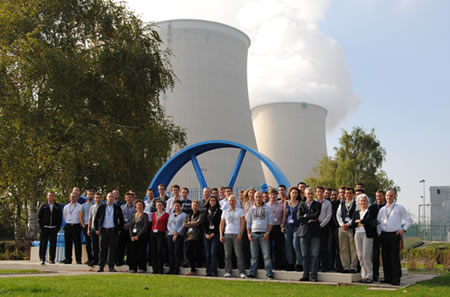
Visit of EDF's Nogent NPP
The conference sessions started on 24 October, in Paris. There were many highlights during these two days. Senior guest speakers shared their knowledge with the participants, especially the Young Generation members. The structure of the presentations enabled attendees to understand the ins and outs of each topic, beginning with presentations that addressed specific technical issues. The debate was then broadened by opening it up to include other closely connected topics. The aims of the lectures were as follows:
To give participants easy access to facts and figures from the entire nuclear value chain
To enable participants to discover the different approaches of key actors active in the field (industrials, operators, academics and politicians)
To provide participants with technical information
To facilitate exchanges with expert speakers
To help participants understand the political context
Luc OURSEL, SFEN’s Chairman and President and Chief Executive Officer of AREVA, opened the two days of conference sessions. During his very enthusiastic presentation he gave an overview of the perspectives for nuclear energy around the world. It was followed by a presentation from Eric MAUCORT, Deputy Director of Nuclear Operations at EDF, on the objectives and challenges facing the nuclear industry.
These presentations were followed by others devoted to specific maintenance and outage activities in the NPPs, which featured the participation, notably, of Christophe BEHAR, Director of the Nuclear Energy Division at the CEA. He explained the CEA’s key activities carried out in support of the operating fleet of NPP’s. Participants also enjoyed presentations from international speakers, notably one on the management of outages given by Steven LAU, First Deputy General Manager at CGNPC and another on the replacement of heavy components by Luc VANHOENACKER, Deputy General Manager of the Nuclear Department of Tractebel Engineering.
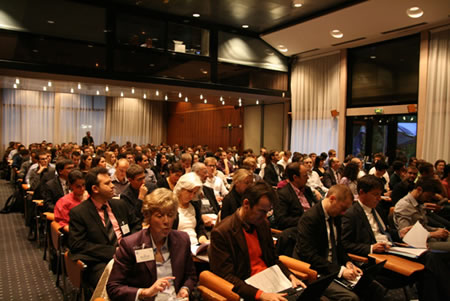
Other presentations focused on related safety issues. These included one by Markus BIRKHOFER, Executive Vice President of AREVA’s Fuel Business Unit, who outlined the importance of fuel design to the performance and safety of NPP’s. Claude JAOUEN, Senior Executive Vic -President at AREVA’s Reactor and Services Business Group, then focused delegates attention on NPPs’ safety and profitability for AREVA’s Installed Base Business.
Participants also had the honour of welcoming André-Claude LACOSTE, Chairman of the French Nuclear Safety Authority (ASN), who gave a presentation on the role of the safety authorities. This presentation was followed by Jacques REPUSSARD, Director General of IRSN (France’s Radiation Protection and Safety Institute), who gave a talk on environmental and health management.
In order to get a more international view on safety issues, Conrad DUBE, Project Manager at WANO, underlined the importance of human performance and safety culture. Such key topics have also been considered for Generation III plants, such as ATMEA1. Takashi KANAGAWA, the ATMEA1 Project Manager, then explained the progress made to date on the operability of Generation III NPP’s.
Denis JANIN, from the SFEN-JG presented upcoming international Young Generation events, such as the ENYGF2013 conference in Sweden and IYNC2014 conference in Spain.
In view of the success of the first three editions of the Atoms for the Future conference, the SFEN-JG is willing to continue to develop and organise this successful event. With its combination of visits and conference sessions it is now a proven concept of great value to both young professionals and companies, who are given a forum to meet and exchange views on a broad range of generic and specific topics.
Since Atoms for the Future offers a large range of benefits we would like to share the concept with other people. Indeed, this event is not only a valuable event for participants, but also gives greater exposure to the SFEN-JG and its activities. Furthermore, after the Fukushima accident, it is necessary to continue to reassure young people who are motivated to meet the challenges of nuclear energy. In our view, sharing experience and knowledge is one possible answer. Atoms for the Future does, indeed, have a bright future.
Next year’s conference is already being prepared: Atoms for the Future 2013 will be devoted to the topic of Nuclear Energy and the Power Grid. It will be held in Paris from 21 - 24 October. The event will give participants a chance to to enjoy technical visits and listen to outstanding presentations. Young professionals and students from all backgrounds and countries are welcome!
All the material presented during the conference sessions is available on our web site at: www.sfenjg.org/The-conferences,551
http://www.euronuclear.org/e-news/e-news-39/ENYGF.htm


In June 2013, Stockholm and Sweden will once more host an international conference for young nuclear professionals. With Vattenfall and Westinghouse as main partners, approximately 400 participants from Europe and beyond will get the opportunity to be informed about the latest news in the industry and establish new valuable contacts for the future!
The last time such an event occured was in 2006, when over 400 young nuclear professionals from 52 different countries came to Stockholm to participate in the International Youth Nuclear Congress, IYNC. The conference was a success and Sweden has now been chosen to host the European Nuclear Young Generation Forum, ENYGF, from June 17th to June 20th.
The conference will consist of lectures from keynote speakers, workshops, presentation of technical papers and unconference. We are proud to present the internationally renowned keynote speaker, Sigval Berg from the United States of America. Mr Berg is recognized for his inspiring lecturers on leadership and how leadership affects people as well as safety culture in organizations. Mr Berg is well acquainted with these subjects from his career having held leading positions in an American Nuclear Power Plant and a nuclear submarine, as well as in the industry associations Institute of Nuclear Power Operations (INPO) and The World Association of Nuclear Operators (WANO). The venue for the conference will be the Royal Institute of Technology premises in Stockholm but technical visits to various Swedish destinations within the nuclear field will also be arranged.
The conference will be organized around the following three themes:
Operation of nuclear power plants. This theme focuses on issues that are relevant to a nuclear power plant during operation, such as safety culture, plant status, experience feedback, power up-rates and maintenance.
Decommissioning and waste. This theme focuses on how nuclear waste is managed, as well as how a nuclear facility can be phased out. Today, Sweden is one of the most advanced countries in the work when it comes to storing spent nuclear fuel in deep repositories, which has attracted great interest among EU member states and others.
Nuclear power in the future. Here, those who are interested in areas such as new-build, new reactor concepts and the political future of nuclear can learn more.
For more information and registreration, visit our website www.ENYGF2013.com or contact us according to the information stated below.
Welcome!
Filip Gottfridsson, Chairman of the Committee for ENYGF 2013
Phone +46 70-296 98 62
E-mail filip.gottfridsson@vattenfall.com
Carolin Cedergren, Market and information chair of the Committee for ENYGF 2013
Phone +46 76-115 45 69
E-mail carolin.cedergren@okg.eon.se
Young Generation (YG) was founded in Sweden in 1994 at the initiative of Jan Runermark, the former president of ABB Atom. The purpose of YG is to develop personal networks, contribute to knowledge transfer between generations and to increase knowledge about nuclear power in a broad perspective.
European Nuclear Society Young Generation Network (ENSYGN) is an collaboration between national Young Generation Networks who organizes biennial conferences on various places in Europe under the name European Nuclear Young Generation Forum, ENYGF. In the summer of 2013 it is Sweden’s turn to organize ENYGF in Stockholm!
http://www.euronuclear.org/e-news/e-news-39/IYNC.htm

The 8th International Youth Nuclear Conference will be held in 2014 in Burgos, Spain, from 6 - 12 July 2014. This meeting for young professionals, young researchers and students will be co-organised by the Spanish Nuclear Young Generation (Jóvenes Nucleares), together with the IYNC Network. It will be the most important international nuclear congress for young people taking place in Spain in the near future.
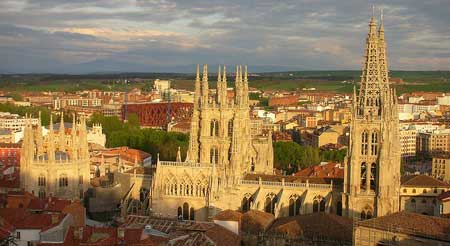
The Spanish Nuclear Young Generation successfully presented its candidature for Burgos at the last IYNC Congress, which took place in Charlotte, USA, in August 2012.
During the Congress a combination of plenary sessions, interactive workshops and debates, as well as more technical sessions covering a wide variety of topics of great interest to the nuclear industry (such as new construction projects, regulations, social perceptions, nuclear and social media, decommissioning, etc.), will be offered to participants. Speakers from different countries around the world will participate, presenting an open and transparent view of the nuclear industry.
Several technical visits will be organised too, since within a short distance of Burgos there are various nuclear facilities to visit. These include the Santa María de Garoña NPP, the Juzbado fuel element manufacturing facility and ENSA, a worldwide leader in the supply of manufactured equipment and services.
IYNC2014 is a unique opportunity to present your research/work by submitting papers. It will provide you with a highly recommended platform to presenting your published research alongside that of other recognised experts in their field. Moreover, a range workshops is aimed at teaching young professionals the knowledge, skills and competences they will need for their future careers will be organized, together with a large number of international colleagues. These workshops will allow you to make new contacts and identify opportunities for cooperation.
In addition to the technical programme, a number of social events will also be scheduled in order to create a relaxed environment for networking and entertainment.
Burgos is a warm and hospitable city, with about 200.000 inhabitants. It has many historic landmarks. For example, its world-renowned cathedral is a breathtaking example of the Gothic stile. And it is also very close to the Guggenheim Museum of Bilbao. The local gastronomy is also well known for its famous morcilla, lamb, paella and tapas.
Burgos is ready to welcome you all!
http://www.euronuclear.org/e-news/e-news-39/gueldner.htm

|
Société Française d’Energie Nucléaire |
 |
SFEN – Jeune Génération – Denis Janin
KTG – Junge Generation – Tobias Zschöckner
Could you briefly present your career to date and highlight its key milestones?
I graduated in Chemistry at the University of Munich. In 1981, my professional career started in radioprotection at Siemens’ nuclear activities department, where I worked as a process engineer. After having held different managerial position within the company, in 1999 I became Siemen’s Head of Nuclear Fuel Business in Europe.
In 2001, I joined Framatome ANP in Germany, before moving to Paris, where I was appointed Executive Vice President of the Fuel Business Unit, in 2006. In 2008, I returned to Germany and joined E.ON as Managing Director.
|
When I stand back and look at my career I see that it has been marked by three major events so far: the Chernobyl accident, which defined new rules for our business; my move to France, where working on the creation of AREVA was a highly valuable experience and returning to Germany to work for a utility, during which time facing the consequences of the Fukushima accident was, of course a major challenge – a challenge that is still on-going. |
Germany decided in March 2011 to phase-out nuclear energy and launch an “energy transition” - the “Energiewende”. How will this affect the country?
First, let me recall the context within which this decision was made. Over the course of a weekend Germany decided to phase-out nuclear energy more rapidly than it had initially decided a couple of months earlier and to shut down 8 units immediately - a decision that put considerable stress on the entire European energy supply system. In my opinion, this was the fastest and most drastic political decision affecting our business that has ever been taken. Personally, as a German and a European citizen, I wonder how a leading European country could take such a far-reaching decision without first consulting with its neighbours.
Before this, the decision that had been taken in 2010 was at least coherent. It had been agreed that an energy transition should be prepared while benefiting from our past investments, and that the phasing-out of nuclear energy should occur progressively, using the profits made from nuclear to support the transition economically. However, as democratic nation we have to accept this decision, which was supported by a majority of German citizens.
But we also have to be aware of the challenges that come with this “Energiewende”. Energy prices will continue to rise and we have to inform people of the full truth about the future consequences of this transition. This is an obligation that our politicians must fulfill.
In contrast, we now have a system where renewable energies are highly subsidised. This is not sustainable as it will lead to electricity prices that are uncompetitive compared with other economies. Furthermore, our grid capacities are insufficient and we need new transmission lines to assure grid stability and security of supply.
Last but not least, I think German citizens need to change their attitude. People here are too often against any new project, not only concerning energy but also other large scale investments, such as the “Stuttgart 21” train station project. This attitude will prove to be a real obstacle to achieving a successful energy transition and, therefore, to ensuring the competitiveness of our economy in the future
What are the consequences for E.ON Kernkraft?
As a company operating nuclear power plants (NPPs) in Germany, E.ON Kernkraft had to shut-down immediately 2 NPP units: Unterweser and Isar 1. Our other plants will be progressively shut down by 2022. In addition, we had to write off several assets while still paying the special tax on nuclear fuel that was decided upon in 2010. And we are also facing new challenges, such as early decommissioning.
We need to ensure that we have enough well-trained staff to operate and maintain our plants, which will remain online for the next 10 years. Our staffing plan shows a rather good match between our needs and our current work force. Nevertheless, we need to recruit new people and provide them with the education required for specific positions in our NPPs. We will first try to recruit them internally from other E.ON units, as we know that hiring external people within this phase-out context will not be easy.
In addition, we have to keep an eye on developments with our current contractors. As with any utility, we need support from our suppliers - especially from the Original Equipment Manufacturers (OEMs) – in order to maintain the safe operation of our NPPs. It is in our best interest to maintain the skills and capabilities of our key suppliers over the next years and even decades.
Are E.ON NPPs prepared to operate beyond their indicated lifetime if this were to be required by the government?
It is difficult to know with certainty where the energy transition will be in 10 years from now. Our current investments are meant to ensure the highest level of safety and reliability for our NPPs. If by 2020 we are asked by the government to extend the lifetime of units that are still in operation, our plants will still be technically able to fulfill this task. However, we are not planning for such an eventuality.
You mentioned decommissioning. Does E.ON already have a decommission strategy for its NPPs?
We have already accumulated experience in decommissioning. In Stade and Würgassen our teams have developed specific skills and a broad knowledge of decommissioning. We intend to use this successful experience to good effect with our forthcoming projects. Our Centre of Competence for Nuclear Decommissioning coordinates these activities from Hanover.
For the units shut down in March 2011, we need first to unload the fuel. This should be done by 2015 for Unterweser and by 2016/17 for Isar 1. Then we need to know under which conditions the waste will be sent to the final disposal and we need certainty about the commissioning of the final disposal site. So far, these decisions have not yet been taken by our government. As this clearly impacts upon our decommissioning strategy we need clear messages and action from the German government.
Decommissioning will become a core activity for our company. We will focus on our projects first, but we might develop this business externally too if we have enough resources to do so - perhaps through the creation of partnerships as we don’t have all the required capabilities in-house and will not take full responsibility over assets from other owners.
The European Commission recently released a report on the so-called “Stress-tests” conducted at all NPPs in Europe. Will the conclusions reached have a large impact upon E.ON plants?
I think that the conclusions of the European Commission have somehow been misunderstood by the press. In the original document from ENSREG it was concluded that German plants – including units planned for shutdown – have a good safety level. No significant improvements for E.ON plants were required following the European stress-tests. Nevertheless, some improvements were implemented even before the EU stress test results were published. Others, like improving the seismic instrumentation in Grohnde, are on-going. We always work according to a process of continuous improvement in order to maintain the highest safety levels.
Globally-speaking nuclear energy seems to be under pressure. What future do you expect for nuclear power?
Nuclear is part of the solution for decarbonising the global energy mix. I am convinced that nuclear energy will grow over the next few years. Renewables will not alone provide the solution, we need base-load power to support our industry and nuclear provides carbon-free base-load power.
As far as new build projects are concerned, we need them to be a success. As projects in France and in Finland are not proceeding as expected we have to restore confidence in our industry. Projects in the US and in China have to be successful to convince investors. Vendors have to confirm their capability to deliver on time and on budget.
Around the world, the picture varies from region to region. A strong increase in nuclear energy is clearly taking place in Asia. This will continue. In the US, shale gas changed the rules and delayed some nuclear new build projects. But if concerns on climate change are reaffirmed, I am confident that new nuclear projects will continue to be launched.
Moreover, some countries are still showing fresh interest in nuclear energy. For example, Arab countries like Saudi Arabia, which today rely mostly on oil. The challenge there is huge as an entire nuclear programme has to be built, including infrastructure, licensing authorities, etc. This might provide a great opportunity for the nuclear industry over the next years.
In Europe too, the situation is diverse. Some countries, e.g. the UK, Poland and the Czech Republic, are intending to extend their nuclear capacities or even to start up new nuclear programmes. Other countries, like Germany, France and Belgium, are willing to decrease or phase-out nuclear energy while installing greater renewables capacity. Regarding nuclear in France, I think EDF will have to both extend the lifetime of its nuclear fleet and launch a new build programme.
Globally, the main challenge for new nuclear development remains competitiveness. In Europe, electricity demand has been reduced due to the economic crisis and prices are still very low. So, any new power plant project is very hard to set up at the moment. We also have to be cautious about what we compare nuclear to in the future: I believe nuclear power is competitive compared to unsubsidised off-shore wind, solar power etc., but if we are ready to reduce our ambitious climate protection targets and develop shale gas it might be difficult for nuclear to compete with this.
Regarding E.ON, we decided to withdraw from two nuclear new build projects in 2012. Hitachi invested around £700m to buy Horizon Nuclear Power, our former joint venture with RWE. I am looking forward to seeing how things develop in the future as the UK desperately needs new nuclear power. On the other hand, we decided to sell our stake in Fennovoima. These decisions are driven by E.ON internal factors such as our need to reduce debt and by external factors like the outlook for European power markets.
We see in the US a great interest in small modular reactors (SMRs). Do you believe that these reactors will play a role in the future of nuclear energy?
Yes! Even if these reactors still have to prove their economic viability, they do seem to present several advantages for the energy sector. Firstly, small means less capital intensive, less risky projects and a faster revenue stream. For private energy companies like E.ON such a cash-flow curve is of particular interest.
Then, standardised and simpler designs based on modules should allow for fast and predictable construction. In addition, these designs might address new or niche markets and could have a broad range of applications - from electricity generation to desalination or heat production. Vendors should continue to work on these products to make them part of the energy solution.
Do you have a message for the Young Generation, students & young professionals who intend to work in the nuclear industry?
Nuclear energy has a future. I am confident that we can operate nuclear power plants in a safe and reliable manner and I see strong potential for further developments of this technology. It is a rather young business and a lot remains to be done: we need young, talented and motivated people to follow in the footsteps of the pioneers who developed it in the last century.
As regards Germany, we have to be pragmatic: I admit that for young engineers it seems not to be the most attractive job opportunity if you are thinking about a career of 40 years. But it still offers challenging tasks and chances to develop personal skills - and why not start in nuclear in Germany first to then go abroad or work for international companies that are based in Germany.
Also, I would like to emphasise the need for young professionals to work continuously on their personal development. Each of us is the sole owner and manager of his or her career. Therefore, it’s important to think about one’s priorities when considering what to do today and tomorrow. Based on such a “roadmap” approach everybody should make his or her decision about what next step to take without being influenced by others. We must seek the continuous development of our skills.
http://www.euronuclear.org/e-news/e-news-39/sck-cen.htm

On Friday 14 December 2012, the first Flemish ESA (European Space Agency) incubation centre was inaugurated, in Geel, Belgium, in the presence of Flemish Minister-President Kris Peeters and Franco Ongaro, ESA Director and Head of the ESA ESTEC (European Space Research and Technology Centre) branch in Noordwijk (the Netherlands).

From left to right: Jacques Nijskens (BELSPO, head of Space research), Frank de Winne (ESA astronaut and Head of the European Astronaut Centre), Kris Peeters (Flemish Minister-President), Ludwig Caluwé (Deputy of the Province of Antwerp and chairman of Innotek), Bruno Naulais (ESA Technology Transfer Programme Office).
The ESA Business Incubation Centre (BIC) is an initiative of the European Space Agency ESA, BELSPO (Belgian Science Policy) and the Flemish Government. The aim is to launch ten new commercial businesses in Flanders over a period of four years. This relates to companies that translate innovative technologies and the know-how arising from space programmes into applications for daily life.
Space technology is often a highly suitable source of intelligent solutions for other sectors, but there are many obstacles to overcome on the road from a creative idea to a successful company. The ESA BICs significantly increase the success rate. As a result, and in addition to their initial objectives - which include telecommunications, meteorology and navigation - space programmes also create new enterprises here on earth and generate local employment.
The Flemish ESA BIC Incubation Centre is co-ordinated by Innotek, the Centre of Excellence for Innovation and Technology, in the province of Antwerp. The Belgian Nuclear Research Centre (SCK-CEN) will provide technological assistance with regards to screening projects, as well as technical support and advice. SCK•CEN will also serve on the ESA BIC Flanders Supervisory Board, which develops the strategic guidelines. ESA BIC Flanders is located in two Innotek business premises in Geel and in Mol, where offices and laboratories are available.
Dirk Ceuterick, of the Business Support Unit (BSU) is the contact person within SCK•CEN. On the Innotek side, Wim Dams is the ESA BIC Flanders Co-ordinator.
ESA BIC Flanders is the latest incubation initiative of ESA’s Technology Transfer Programme Office. There are currently centres in Germany, the Netherlands, Great Britain, Belgium and Italy. All ESA BICs work together with local partners wherever possible.
http://www.euronuclear.org/e-news/e-news-39/CNE.htm

For the 6th consecutive year the French CNE (see below) has issued its report on the R&D related to radioactive waste that is being carried out by Andra, CEA and others. It has also issued an ‘Opinion on the management of radioactive materials and waste,’ in answer to a request from the French parliament. ENS NEWS received from Frank Deconinck, Professor of Biomedical Physics at the Vrije Universiteit Brussel (Free University of Brussels) and Chairman of the Board of the Belgian Nuclear Research Centre (SCK•CEN), the following English translation of the opening paper of this report. The English version of the full report will be posted on the web shortly (www.cne2.fr/).
(Editor-in-Chief)
The nuclear industry produces long-lived radioactive substances. Some of these come in the form of waste. Ethics and sustainable development prohibit the industry from passing on the burden and responsibility for looking after this waste to future generations. Surface storage must only be a medium-term stopgap. Based on expert advice, the countries concerned have concluded that the solution that provides all the necessary safeguards is deep geological disposal. The Law of 2006 (the “Loi Bataille-Biraux”) adopted this method for the management of French waste, in conjunction with a reversibility clause for a period of at least a century. Other forms of waste, including plutonium and depleted uranium, can be used as resources for a new generation of reactors. These must first be made more efficient and even safer. Their implementation would ensure France's independence, in terms of electricity production, for several centuries. The same Law of 2006 confirmed the mission given to CNE2, namely to annually submit to Parliament a report and an opinion on the progress and quality of the studies, research and developments carried out in the fields of deep geological waste disposal and on the transmutation of radioactive materials by means of Generation IV reactors.
Drawing on more than twenty years of experience gained through listening to those concerned and to carrying out assessments of the facilities and laboratories that contribute to this initiative - both in France and abroad - CNE2 believes it is justified in saying today that:
1. The glass packages and clay in deep geological repositories are effective barriers for containing fission products and actinides for hundreds of thousands of years. This provides enough time to reduce their harmfulness to a level where it no longer poses a problem for people living above the disposal facility.
2. The Meuse/Haute-Marne geological site was selected for detailed studies because it offers a clay layer of over 130 metres thick and 500 metres deep that has demonstrated excellent containment qualities: stability for at least 100 million years, very slow water circulation and a high holding-capacity of radionuclides.
3. The design of the structure that is to be built - shafts, tunnels, cavities, ventilation, seals etc. - and the development of the methods and procedures necessary for guaranteeing safety during its operation and after final closure, are currently being studied. They are sufficiently advanced to enter the industrial phase, in accordance with the law. This is a specific implementation project, with all the necessary development, innovation and engineering steps having been taken. It must be carefully monitored. The review in 2015 of the application for authorisation to create the disposal facility will be an important milestone in this monitoring process.
4. The plutonium produced in the fuel cycle is a dangerous substance, but it may also become a valuable resource if used in fast neutron reactors. These reactors have the added benefit of consuming depleted uranium, for which there is currently no use, which would relieve the heavy burden on mining and enrichment. Moreover, they could potentially be used to transmute minor actinides into shorter lived isotopes. Research and development dedicated to fast neutron reactors has already validated their scientific and technical feasibility. In order to test their industrial and economic viability an experimental reactor and its corresponding cycle - fuel fabrication and reprocessing - are essential. Its implementation, under the Law of 2006, preserves a range of energy choices, strengthens French expertise in the civil nuclear industry and ensures that France and Europe are competitive on the world stage.
CNE2 was formed to carry out an annual assessment of the progress made in research on the management of radioactive materials and waste. This assessment results in an annual report submitted to the Parliamentary Office for the Evaluation of Scientific and Technological Choices (OPECST). Besides the French research that is assessed in relation to the guidelines established by the National Plan for the management of radioactive materials and waste (PNGMDR), the report also looks at research conducted abroad. Since its creation in 2006, the CNE2 Board has produced six annual reports, the most recent of which has just been published. The CNE2 Board was formed by the aforementioned Law of 28 June 2006, the so-called 'Bataille-Biraux' Law, which lays down the provisions established in France for the management of radioactive waste.
The CNE2 Board has twelve members, chosen based on recommendations from the Académie des Sciences, the Académie des Sciences Morales et Politiques and the OPECST. For its evaluation work, the CNE2 Board is totally independent and conducts hearings of the organisations that perform research into the management of radioactive materials and waste. A dozen or so day-long hearings are held each year. In order to encourage scientific discussion related to this work, which is by nature multidisciplinary, each hearing is attended by the stakeholders involved. The most important of these are Andra, which coordinates research into reversible geological disposal and storage, and CEA, which coordinates the research that is carried out in partitioning & transmutation.
According to the law, these organisations must provide the CNE2 Board with any information that it deems necessary.
http://www.euronuclear.org/e-news/e-news-39/linn.htm

The new 10-page sales list of used- and prototypes as well as trade fair products is now retrievable on www.linn-high-therm.de/special-offers.html.
Since 1969, Linn High Therm, Eschenfelden, Germany, is one of the leading manufacturers of electrically heated industrial and laboratory furnaces / kilns, high frequency generators and medium frequency inverters for induction heating, sample preparation units for spectroscopy, precision fine casting machines as well as for microwave drying and heating units. Especially manufacturing of special units according to customer’s specifications belong to our product range. We have own offices in Russia (Moscow), China (Shanghai) and more than 50 agents and representatives all over the world.

http://www.euronuclear.org/e-news/e-news-39/other-conferences.htm
3 - 7 March 2013
Shenzhen, Guangdong, China
more

7 - 11 April 2013
Avignon, France
more
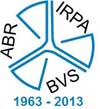
8 - 10 April 2013
Brussels, Belgium
more

EMRS Symposium
27 - 31 May 2013
Strasbourg, France
more
![]()
17 - 20 June 2013
Stockholm, Sweden
more

18 - 20 June 2013
Trnava, Slovakia
more
![]()
23 - 27 June 2013
Marseille, France
more

8 - 12 September 2013
Brussels, Belgium
more
![]()
9 - 12 September 2013
Bled, Slovenia
more

15 - 19 September 2013
Charlotte, NC, USA
more
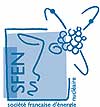
Joint International Conference on "Supercomputing in Nuclear Applications + Monte Carlo"
27 - 31 October 2013
Paris, France
more
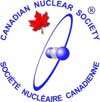
24 - 28 August 2014
Vancouver, Canada
more
http://www.euronuclear.org/e-news/e-news-37/Member-Societies.htm

Austrian
Nuclear Society |
Belgian
Nuclear Society |
Bulgarian
Nuclear Society |
Croatian
Nuclear Society |
Czech Nuclear Society |
Finnish
Nuclear Society |
French
Nuclear Energy Society (SFEN) |
German
Nuclear Society (KTG) |
Hungarian
Nuclear Society |
The
Israel Nuclear Society |
Italian
Nuclear Association |
Lithuanian
Nuclear Energy Association |
Netherlands Nuclear Society |
The Nuclear Institute |
Nuclear
Society of Russia |
Nuclear
Society of Serbia |
Nuclear
Society of Slovenia |
Polish
Nuclear Society |
Romanian
Nuclear Energy Association (AREN) |
Slovak
Nuclear Society |
Spanish
Nuclear Society |
Swedish
Nuclear Society |
Swiss
Nuclear Society |
http://www.euronuclear.org/e-news/e-news-37/Corporate-Members.htm
Links to ENS Corporate Members |
AF-Colenco Ltd., Nuclear Technology
Department |
Alpiq Ltd |
Alpiq Suisse Ltd. |
Andritz AG |
Ansaldo Nucleare S.p.A |
AREVA NP |
AREVA NP GmbH |
Atomic Energy Council (AEC) |
Atomic Energy of Canada Limited (AECL) |
Atomexpo LLC |
Atomtex SPE |
Axpo AG |
BKW FMB Energie AG |
Chilean Nuclear Energy Commisssion |
CCI AG (formerly Sulzer Thermtec Ltd) |
Design Bureau "Promengineering" |
NV Elektriciteits-Produktiemaatschappij
Zuid-Nederland EPZ (Electricity Generating Co. Ltd in the
Southern Netherlands) |
E.O.N Kernkraft GmbH |
Euro Nuclear Services BV |
Electrabel, Generation Department |
Electricité de France (EDF), Communication Division |
ENUSA Industrias Avanzadas SA |
EXCEL Services Corporation |
GE Nuclear Energy |
IEA of Japan Co. Ltd |
Japan Electric Power Information Center (JEPIC) link |
Kernkraftwerk Gösgen-Däniken
AG |
Kernkraftwerk Leibstadt AG (KKL), |
L-3 Communications MAPPS Inc. |
Linn High Therm GmbH |
Elektroinstitut Milan Vidmar |
NRG Arnhem |
NRG Petten |
NUKEM Technologies GmbH |
ONET TECHNOLOGIES |
Paks Nuclear Power Plant Ltd |
Paul Scherrer Institute |
Polimaster Ltd |
Siempelkamp Nukleartechnik
GmbH |
|
SKB (Swedish Nuclear Fuel and Waste Management
Company) |
Studiecentrum voor Kernenergie, Centre d’Etude
de l’Energie Nucléaire SCK/CEN |
Synatom |
Taiwan Atomic Energy Council (AEC) |
Taiwan Power Company (Taipower) |
"Technoatomenergo" Close Joint-Stock
Company |
Teollisuuden Voima Oyj / Industrial Power
Company Ltd (TVO) |
Tractebel Engineering S. A. |
UNESA |
Urenco Limited |
Vattenfall AB |
VNS – Vinçotte Nuclear Safety |
VTT Nuclear |
Westinghouse Electric Company |
World Association of Nuclear Operators
(WANO), |
|
http://www.euronuclear.org/e-news/e-news-37/editorial.htm

Editorial Staff:
Mark O’Donovan, Editor-in-Chief
Contributors to this Issue:
Helmuth Böck (ENS HSC)
Carolin Cedergren (ENS YGN)
Guillaume Chaud (French Young Generation)
Frank Deconinck (Free University Brussels)
Kirsten Epskamp (ENS)
Andrei Goicea (ENS YGN)
Filip Gottfridsson (ENS YGN)
Ingeborg Hagenlocher (ENS HSC)
Denis Janin (French Young Generation)
Emilia Janisz (ENS)
Tereza Melicherová (SNUS)
Dimitar Popov (ENS HSC)
Elena Sima (AMEC Nuclear Ro, Romania)
Marco Streit (ENS)
Mitja Uršič (Nuclear Society of Slovenia)
Tobias Zschöckner (German Young Generation)
Realisation:
Marion Brünglinghaus
Rue Belliard 65, BE-1040 Brussels
Phone +32 2 505 30 50 - Fax: +32 2 502 39 02
E-mail: info@euronuclear.org - http://www.euronuclear.org
The ENS News is a quarterly publication, in electronic
form only.
Copyright notice ©2013 European Nuclear Society.
Reproduction is authorised provided that the ENS News is acknowledged as the
source – except where otherwise stated.
![]()
© European Nuclear Society, 2013